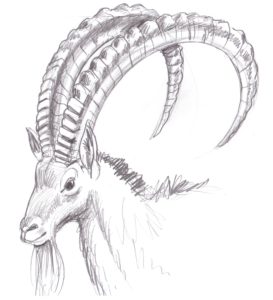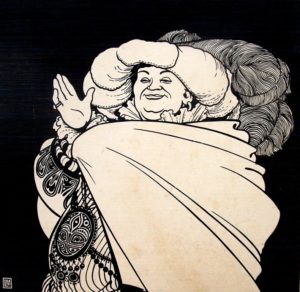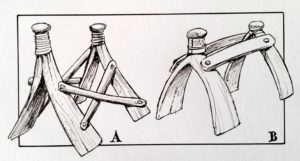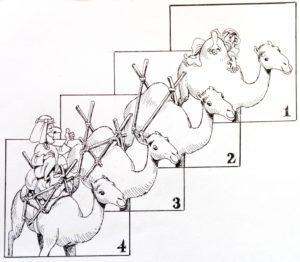In 1271 when Marco Polo left Venice at the start of his journey to the land of the Kublai Khan, there was another Marco that traveled with the expedition.
In the book, ‘The Other Marco’, Tom arrives at the port city of Acre on the boat from Venice carrying the Polo expedition. His only knowledge of the place is that Christian Crusaders ruled the port but the surrounding area, all the way to Jerusalem and beyond was Saracen [Muslim] territory. Saracen was the term used for Muslim warriors by Europeans on the voyage. TOM is mostly fearful of these soldiers even without knowing the turbulent history of the Crusader wars that had for hundreds of years been waged in this region.
A very quick look at the story of the Crusades might be appropriate at this point.

A Crusader Knight, his armour covered in a white shroud facing a Saracen Warrior
As the Roman Empire began to crumble in the west, Constantine I moved his capitol to the ruined city of Byzantium in the east and established his New Rome. The city was renamed Constantinople and his empire, Byzantine. His realm included the Christian Holy lands around Jerusalem.
300 years later the Arabs defeated the Byzantines at the Battle of Yarmuk, and Jerusalem was captured. They ruled for 100 years and where then overthrown by Abbasid Caliphate who established an Islamic Empire for 350 years.
During these 450 years the Catholic Church had grown and replaced the Roman Empire to become a powerful ruling force in Rome and Europe. Pope Urban II urged Christian leaders in the west to join a crusade to evict the Muslims [Islamic Empire] from Jerusalem. The 1st Crusade was successful when Godfrey of Bouillion recaptured Jerusalem and assumed the title: ‘Defender of the Holy Sepulchre’.
100 years later Sultan Saladin defeated the Christians at the Battle of Hattin and occupied Jerusalem. Richard the Lionheart called for a truce with Saladin who allowed Christians pilgrims safe passage to and from their Holy City.
The fortunes of Jerusalem swayed backwards and forwards for over 150 years between Christian and Muslim occupation. Battles determined some of the outcomes, negotiation decided others. At least two of the Crusader leaders died before reaching their objectives. In all 8 Crusades were mounted with mixed success.
TOM arrives in Acre in 1271 when it is still in Christian hands, but 20 years later the Crusades eventually peters out with the fall of Acre in 1291, and it remains a Muslim port till the end of World War II.
An interesting bit of purported history at the time of the Polo expeditions is that the Kublai Khan asked the Polo brothers to return to Cathay with one hundred Catholic Priests and a jar of holy oil from the Church of the Sepulchre in Jerusalem. They managed to secure the oil but only two Priests started the journey to Cathay, turning back in fear of the war in Armenia on the way. It is said that the Mongolian leader wanted the priests to convert his followers to Christianity. They missed the opportunity and just over 50 years later the Mongolians converted to Islam in 1323 with the Treaty of Aleppo.
The mind boggles when one tries to imagine a Catholic presence in most of Asia as there is in South America today for example.
The Polo expedition turned south to avoid the hostilities in Armenia and after making a huge detour to Hormuz on what is known as the Gulf of Oman today, they retraced their steps and crossed over the western end of the Himalaya range called the Pamirs. This was one of the accepted silk road trade routes, but the merchants preferred the northern route through Bukhara and Samarkand as it was obviously warmer.
In ‘The Other Marco’ story, Tom struggles with the cold mountain air and deep snow as he leads his horse through the wet mist. Adding to this discomfort he has a frightening experience. The short paragraph below is taken from the book.
‘I was tired, and my eyes burned, trying to see through the white glare around me. Suddenly the mist swirled and there, right in front of me, barring my way, stood a huge hairy animal with massive curved horns. Before I could cry out the mist closed in around me and the vision was gone.’
Imagine being confronted by this creature in the swirling mist!
During the research of the Pamir area for the book, I came across some pictures of the Himalayan Ibex and was astounded by the size of its curved horns. Perhaps for the very reason that I imagined how terrifying it would be to meet such an apparition in the mist, I allowed Tom to do just that – meet the ‘monster’. I would like to add a comment here before you think of me as a sadistic tormenter of a young, travel wary boy; I feel every emotion personally as I write. I would not be able to describe the sensation if I did not experience it myself. Writing is a wonderful yo-yo of passionate emotions and I even have to wipe away a tear from time to time. I call it: ‘Living the words!’
Another sketch or two of these magnificent creatures will not be out of place here. Enjoy.

Thanks for staying with me to the end of this posting.
TOM #4 will be available in a fortnight. #4 being an even number means that the Monsters 4 Monsters corner will be back with a scary picture.









